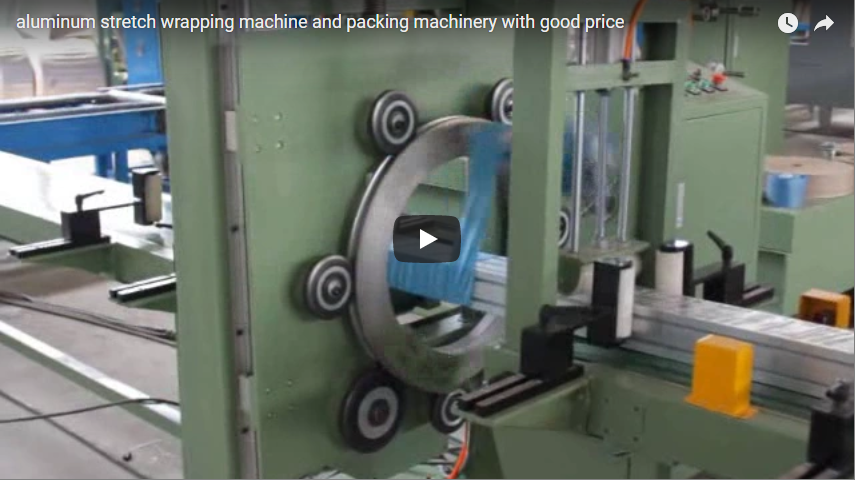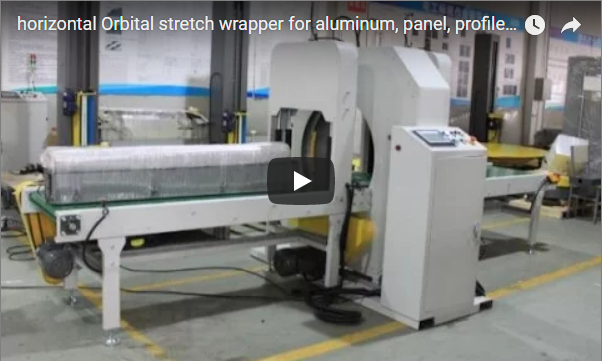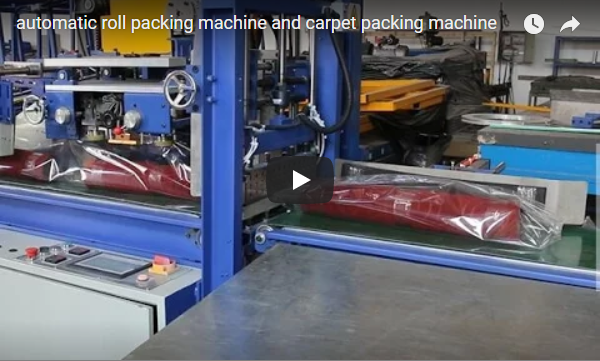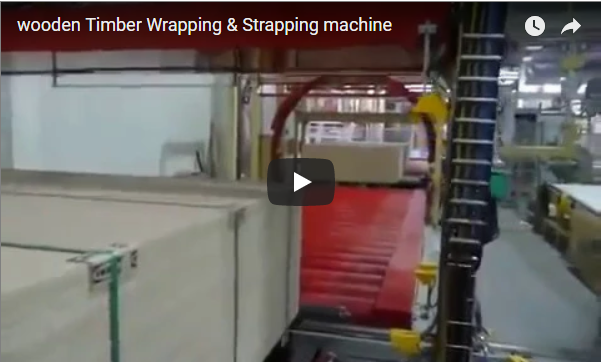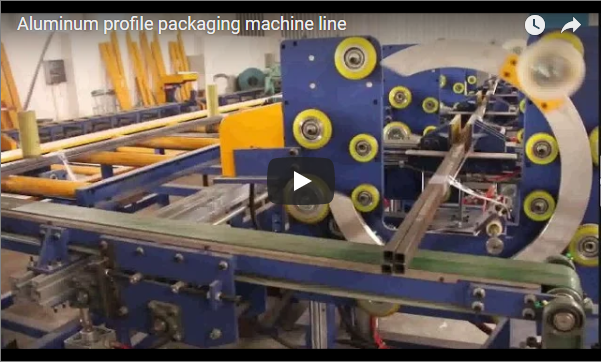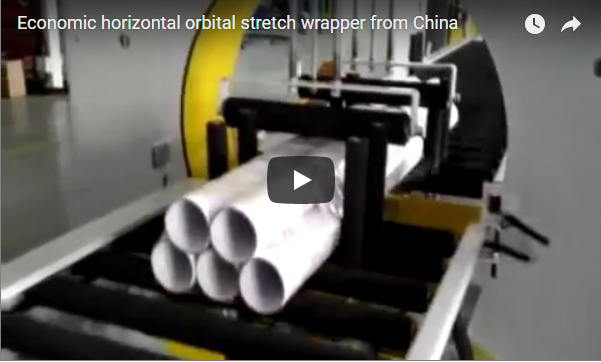Mastering the E100 Horizontal Stretch Wrapper: Operation, Specs, and Best Practices
Wrapping long, heavy, or irregularly shaped items like pipes, lumber, extrusions, or doors presents unique challenges in packaging. Traditional turntable stretch wrappers often fall short. This is where horizontal stretch wrapping machines, such as the E100 model, provide an effective automated solution, ensuring load stability and protection during transit and storage. This guide delves into the operation, key considerations, and practical insights for leveraging the E100 horizontal stretch wrapper effectively.
1. Understanding the Horizontal Stretch Wrapping Principle
Unlike turntable wrappers where the load rotates on a platform, a horizontal stretch wrapper (often called an orbital wrapper or ring wrapper) keeps the product stationary relative to its path of travel.
- The product moves horizontally along a conveyor system.
- A vertical rotating ring holds the stretch film roll.
- As the product passes through the ring's opening, the ring orbits around it, dispensing the stretch film and wrapping the load securely.
This method is inherently suited for products that are significantly longer than they are wide or tall.
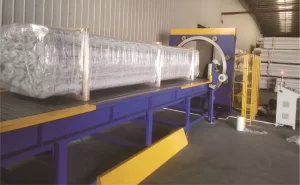
1horizontal wrapping machine gg1500 ce approved convey jpg 2. Key Technical Considerations for the E100 (Typical Parameters)
While specific configurations can vary, understanding the typical technical parameters of a machine like the E100 is crucial for assessing its suitability and optimizing its performance:
- Ring Speed: Determines the wrapping RPM (Revolutions Per Minute). Variable speed control allows adjustment based on product fragility and desired throughput. Common ranges might be [Insert typical RPM range, e.g., 30-90 RPM, if known, otherwise state 'Variable based on configuration'].
- Conveyor Speed: Adjustable speed to match production line requirements and ensure proper wrap overlap. Usually measured in meters or feet per minute.
- Maximum Product Dimensions: Defines the largest size (Length x Width x Height) that can pass through the wrapping ring opening. Crucial for matching machine capability to product range.
- Stretch Film Specifications:
- Film Width: Standard widths supported (e.g., 500mm).
- Film Type: Compatibility with different stretch film types (e.g., cast, blown) and thicknesses (gauge).
- Pre-stretch Capability: Powered pre-stretch systems significantly reduce film consumption and improve load containment. Understanding the percentage of pre-stretch (e.g., up to 250%) is vital.
- Control System: Typically utilizes a PLC (Programmable Logic Controller) with a user-friendly HMI (Human-Machine Interface) or touch screen for setting parameters like wrap counts, tension, overlap, and conveyor speed.
- Power Requirements: Voltage, phase, and power consumption (e.g., 220V/3Ph/60Hz, ~3-5 kW).
- Pneumatic Requirements: Required air pressure (PSI or Bar) if pneumatic components are used (e.g., for film clamping/cutting).
3. Operational Best Practices and Experience Sharing
Getting the most out of your E100 involves more than just pressing 'start'. Here are some practical tips based on operational experience:
- Consistent Product Infeed: Ensure products enter the machine centered and properly aligned on the conveyor. Misalignment can lead to uneven wraps or jams. Guide rails should be adjusted correctly for the product dimensions.
- Optimizing Film Tension and Pre-stretch:
- Correct tension is critical: Too loose, and the load isn't secure; too tight, and fragile products might be damaged, or the film could break.
- Utilize the pre-stretch function effectively. Higher pre-stretch saves film but requires good quality film and careful tension adjustment. Start with recommended settings and adjust based on load stability tests.
- Fine-tuning Wrap Parameters:
- Overlap: Adjust conveyor speed relative to ring speed to control how much each wrap layer overlaps the previous one. More overlap generally means better protection and stability but uses more film. 50% overlap is a common starting point.
- Start/End Wraps: Program sufficient wraps at the leading and trailing ends of the product, as these are often vulnerable points.
- Film Clamping and Cutting: Ensure automatic film clamp and cut mechanisms are working correctly. Poor cuts can lead to film tails that snag, while clamp failures can stop the cycle. Keep blades sharp and mechanisms clean.
- Routine Maintenance Checks:
- Regularly inspect and clean film carriage rollers. Residue buildup can affect pre-stretch and tension.
- Check drive belts/chains for proper tension and wear.
- Lubricate moving parts according to the manufacturer's schedule.
- Inspect safety sensors and emergency stops.
- Safety First: Always follow safety procedures. Ensure all guards are in place during operation. Utilize lockout/tagout procedures during maintenance. Provide proper operator training on both operation and safety.
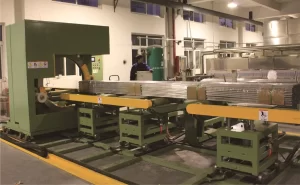
horizontal orbital stretch wrapper52 jpg 4. Enhanced Protection and Efficiency: The Benefits Realized
The advantages of using a horizontal stretch wrapper like the E100 extend beyond basic packaging:
- Superior Load Containment for Long Items: Effectively unitizes bundles of lumber, pipes, or extrusions, preventing shifting and separation during handling and transport.
- Product Protection: Creates a protective barrier against dust, moisture, dirt, and superficial damage. Opaque or UV-resistant film can be used for added protection.
- Increased Throughput: Automating the wrapping process significantly speeds up packaging compared to manual methods, reducing labor costs and bottlenecks.
- Consistency: Ensures every product is wrapped to the same standard, improving load integrity and professional appearance.
- Versatility: Can handle a wide variety of product lengths and profiles with appropriate setup and configuration.
5. Integrating the E100 into Your Packaging Line
Consider how the E100 fits within your overall production flow. Integration with upstream and downstream conveyors, labeling systems, or banding equipment can create a seamless automated packaging line. Ensure adequate space for machine operation, maintenance access, and product staging.
Conclusion
The E100 horizontal stretch wrapping machine offers a robust and efficient solution for packaging long, bulky, or heavy products. By understanding its operating principles, key technical specifications, and implementing best practices for operation and maintenance, businesses can significantly enhance their packaging efficiency, improve product protection, and ensure load stability throughout the supply chain. Proper setup and skilled operation are key to maximizing the return on investment for this essential piece of packaging automation.
For further details on horizontal wrapping solutions, see:
https://www.fhopepack.com/Horizontal_wrapping_machine.html
(Optional: Add relevant external link here if desired, e.g., to a PMMI resource on stretch wrapping standards or a guide on choosing stretch film types from a reputable source like) [Link to authoritative source on stretch film fundamentals, e.g., Wikipedia page on Stretch wrap or industry resource].

